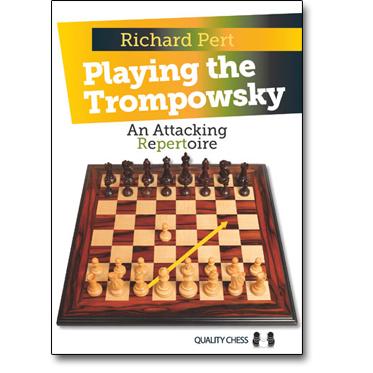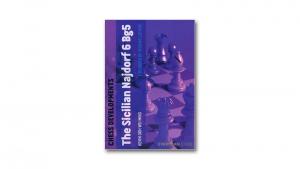
Review: Playing the Trompowsky
I recently took a train from Amsterdam to the quaint little Belgium town of Bruges. Looking for a book to keep me occupied for the four hour ride, I remembered my review copy of Richard Pert’s Playing the Trompowsky, which is certainly thinner than most of the books coming out of Quality Chess. And indeed, I was able to read the whole book, cover to cover, during the ride; the one adjective that first comes to mind when you pick up Pert’s work is Short. It’s only 260 pages despite claiming to be a complete repertoire book (compare this to GM John Shaw’s book on the King’s Gambit, at 680 pages and for the same cost!).
The other reason I was a bit sceptical to read this book was that I found it hard to believe enough had changed in the slow-moving theory of the Trompowsky to warrant a new publication. I was a huge fan of GM Peter Wells’ much-revered Winning With the Trompowsky (2003, Batsford), while IM Richard Palliser’s Starting Out: The Trompowsky (2009, Everyman) did a good job updating the theory and providing a guide for those wanting to, well, start out. Could a new book really find a niche between these two great books?
Fortunately, I was pleasantly surprised – so much so that I decided to reread the book on the four hour return journey to Amsterdam. Pert very clearly says that his book aims to build on these and other previous works, and in fact I think a true Trompowsky player would do well (and lose little) by sitting this book next to Wells and Palliser on the shelf. In particular, the chief contributions of this book are to go over existing theory with a fine-tooth comb (and a strong engine), address the main defences suggested by popular authors from the black side, and offer detailed coverage of White’s rarer, trickier systems to give the white player more options. And yes, Pert manages to pack this in to 250 pages. Not bad!
One explanation for the achieved compression may be that Pert has really gone for his own Tromp repertoire, rather than detailing all of White's sidelines. I don't mind this approach, as most of the omitted lines are the dubious ones in any case. However, if you're after some material on, say, the wacky 1.d4 Nf6 2.Bg5 Ne4 3.Bh4!? (ala Mamedyarov), or even 3.h4!? (ala Rapport), you'd best look elsewhere. Pert is devoted to the main line 3.Bf4, but does present chapters on both 3...c5 4.d5 and 3...c5 4.f3 for consideration. His main recommendation against 2...c5 is the standard 3.d5, although a chapter on 3.Nc3!? is included for variety. Likewise, in addition to Pert's main recommendation 2...e6 3.e4 (with his patented 3...h6 4.Bxf6 Qxf6 5.c3!?), there is a chapter on the more positional 3.Nd2. Such flexibility is useful for a full-time Tromp player; when one's chief white repertoire is less principled, the ability to switch between lines is often a strong practical weapon.
Being a repertoire book, Playing the Trompowsky also covers 1.d4 d5 2.Bg5!? as well as 1.d4 f5 2.Bg5. The former, as Pert rightly points out, is not very threatening, but is certainly a useful addition to a white arsenal. Pert is particularly proud with his efforts on the latter anti-Dutch system, which he considers to be extremely promising for Black. Certainly, he has some excellent stuff in this small chapter at the end of the book, and after my first reading, I was bursting at the thought of getting to try 2.Bg5 against an unsuspecting Dutch player (from the opening, not the country!). However, as far as I can see, there might be a big hole in one of his main lines. After 1.d4 f5 2.Bg5 h6 3.Bh4 g5 4.e4 Nf6 5.e5 e6 6.Bg3 f4 7.Bd3('!', although Moiseenko recently tried 7.exf6 with some success) ...d5 8.exf6, Pert gives a line without comment that leads to '±'. However, a rather dangerous novelty 12...g4! seems to give Black the better chances.
This whole line is rare and underexplored, though, so there is scope for improvement for both sides, and in general I think Pert's choice of 1.d4 f5 2.Bg5 is a good one.
I don’t like to publish opening book reviews without having tried out the recommendations for myself first. So I took the time to study Pert’s suggested repertoire and try it out in a few tournament games. The consequences were quite instructive for what I see as the key strengths and weaknesses of the book. Against the theoretical Alina l’Ami, I was able to employ the Vaganian Gambit, about which Pert has a lot to say. 8…Qd8 isn’t covered in the book (although it is slightly the more popular move), but I was able to adopt the ideas Pert discussed against Black’s other options to find the best continuation. White was quickly able to build up a powerful attack and was winning a couple of moves later, although I later mucked it up and allowed a draw.
This is a good example about how the detailed analysis in the book of various attacking Trompowsky gambits can easily pick up the reader a bunch of points at club level, and I was very happy with the result of my preparation. Pert’s work is particularly strong when it comes to the gambit lines he discusses, as, even when chess engines initially laugh at his sacrificial suggestions, I generally find his attacking intuition to be proved correct.
My second Tromp foray, however, was less successful. The rising Norwegian star Johan Salomon played 2…d5 to which I responded with 3.Bxf6 - Pert says “there is a case for saying it is White’s strongest move” [p.142]. Johan replied with 3…gxf6!?, and in response to Pert’s suggested 4.c4, quickly countered with 4…e5!. I sunk into a half-hour think at this point, eventually resigning myself to the fact that Black has excellent activity and counterplay of a Chigorin/Albin variety, only with the two bishops and a semi-open g-file to boot. I played 5.Nc3 and was immediately hit with 5…dxc4, after which I could find nothing better than to bail out to equality with 6.dxe5, managing to squeeze out a win in a long endgame.
Later, I checked the line in the book, to find that Pert is predictably overly optimistic about White’s chances after his suggested 6.Nf3; in fact, Black seems to be able to get a slightly better endgame with natural moves. This is the one problem with the book, which to be fair is a common flaw in many opening books: Pert is occasionally too optimistic about White’s chances in sidelines that are either considered non-critical or non-forcing. However, most regular readers of chess books learn to develop a sort of filter for author language, and are canny enough to understand that phrases such as “with a more pleasant endgame for White” often mean in reality “the game is drawn with best play”.
It’s a shame, but not too surprising, that Pert sometimes succumbs to wearing rose-tinted glasses in his assessments of some of the less popular alternatives. But this is really the only complaint I can make about an otherwise excellent book that should suit the purposes of chess players at all levels. Moreover, in the specific case of my game against Salomon, there is a very easy fix: the more positional 3.e3! is the current ‘Grandmaster’s Choice’ against 2…d5, and is also well covered in the book. This Torre-like approach isn't given much attention in previous works, as it's only recently become fashionable, but has been employed in the last couple of years by big names such as Carlsen, Nakamura and Adams. This is a good example of how the extra options that Pert gives for White against various black systems means that the reader always has the chance to modify a Tromp repertoire to suit style as well as theoretical developments. Again, I'll repeat that the strength of this book lies in the more attacking, sacrificial lines, and indeed I feel that, when Pert offers two choices for White, the aggressive option is usually of higher quality. I have a feeling that this reflects Pert's own individual style, and his strong ability to combine attacking intuition with engine output to provide original analysis. The flip side of this is that there is a definite sparseness to the amount of positional explanation in the book, something I appreciated in, for example, Wells' work. I guess that's something we should expect more of in this engine-driven chess age!
The layout, typesetting and editing follow the standard Quality Chess recipe: clear, simple, thorough. The book is an easy, pleasant read, whether in front of a chess board or passing time on a train. Overall, I can highly recommend this book, which is both theoretically robust and entertaining to read, and makes a convenient travel companion to tournaments. Just bring a grain of salt or two to your first reading!
Structure:
1 2…e6 3.e4
2 2…e6 3.Nd2!?
3 2…c5 3.Nc3!?
4 2…c5 3.d5
5 2…Ne4 3.Bf4 c5 4.d4
6 2…Ne4 3.Bf4 c5 4.f3
7 2…d5 3.Bxf6
8 2…d5 3.e3
9 2…Ne4 3.Bf4 d5 4.e3
10 Rare 3rd moves
11 Rare 2nd Moves
12 2.Bg5 against the Dutch
13 1.d4 d5 2.Bg5






